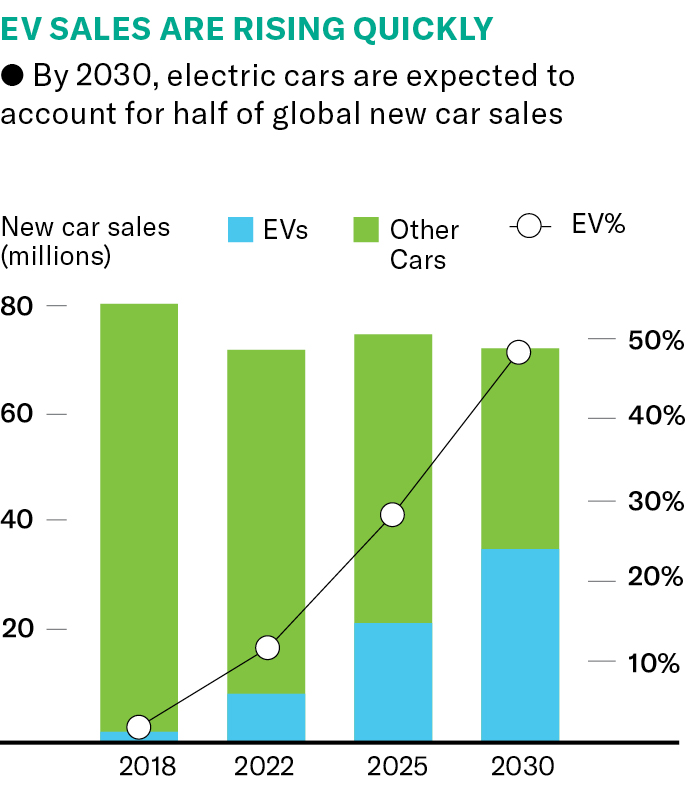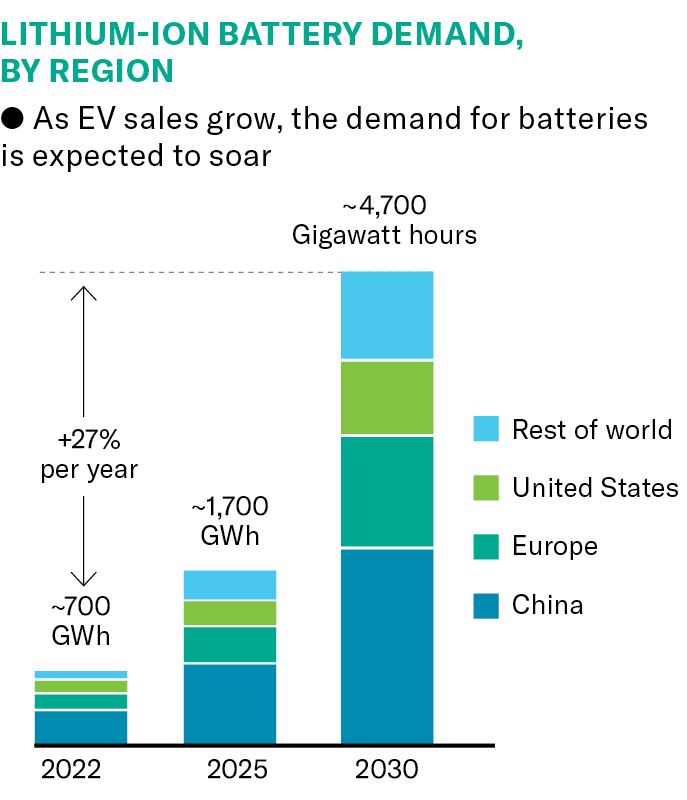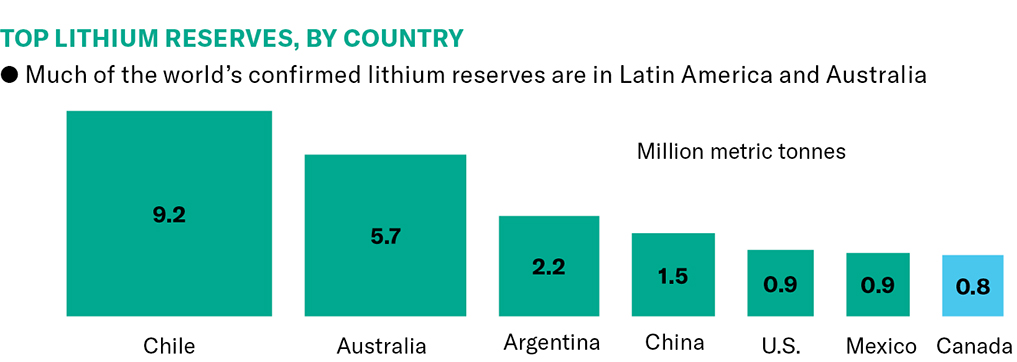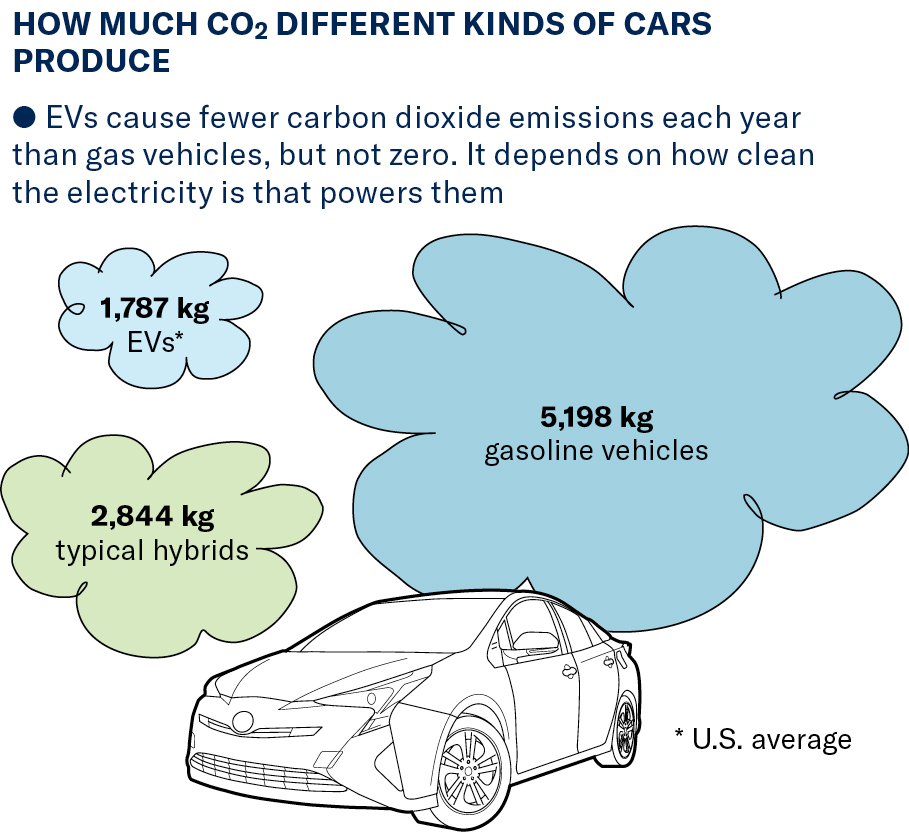As more electric vehicles hum past on city streets, and more charging stations appear on roads and in parking garages, it’s easy to imagine that we are winning the fight against climate change, one electric car at a time.
But electric vehicles by themselves are not a silver bullet to the problem of transportation pollution and climate change. And as we ramp up their use, they will create new problems that will have to be solved, warn U of T researchers who study transportation and climate.
“There is no future without electrification. But just electrification will not get us there,” says Marianne Hatzopoulou, a professor in U of T’s department of civil and mineral engineering. “We don’t want to fall into the trap of thinking that if we support electric vehicles, we’ve solved the problem.”
The transition to electric vehicles is already well on its way. Globally, electric cars made up 14 per cent of new sales in 2022, according to the International Energy Agency. In Canada, all-electric vehicles accounted for seven per cent of new car sales at the beginning of 2023.
At the UN Climate Change Conference in 2022, the Accelerating to Zero Coalition pledged to make all new cars and vans zero-emission by 2035 in leading markets, and by 2040 globally. Canada is currently considering regulations that would require automakers to ensure that 60 per cent of new passenger vehicles available for sale in 2030 are zero-emission, rising to 100 per cent by 2035.

Daniel Posen is an associate professor in U of T’s department of civil and mineral engineering, and the Canada Research Chair in system-scale environmental impacts of energy and transport technologies. He agrees electrification is vital. But relying solely on electric vehicles to reduce carbon emissions from transportation may not be enough, especially if we want to do it in time to stop a catastrophic two-degree rise in global temperatures.
To get an idea of the scale of the problem, Posen, along with Heather MacLean, a professor in U of T’s department of civil and mineral engineering, and postdoctoral researcher Alexandre Milovanoff, looked at how quickly the U.S. would need to electrify transport in order to meet emission goals that would keep warming to less than two degrees.
By 2050, the U.S. would need 90 per cent of all passenger vehicles on the road to be electric – 350 million vehicles. Right now, it has about a million. Considering how long cars last, that would probably mean by 2035 every new car sold would have to be electric.
If the U.S. could get that many EVs on the road that quickly, it would have to increase the electricity it generates by 1,700 terawatt-hours per year – or by about 40 per cent of its total production in 2021.
Posen says that there’s no similar analysis for Canada, but this country will likely face similar challenges in ramping up its electricity production. The problem is especially challenging because, to get the full benefit of EVs, the electricity that powers them – and how they’re manufactured – should be green. If not, you could end up with an EV that creates more greenhouse gases than an efficient gasoline-powered car.
We have to move to a path of decarbonization, but we have to choose that path very soberly”
For example, when you take emissions from manufacturing into account, an EV using electricity in a place like coal-dependent West Virginia will emit about six per cent more greenhouse gases over its entire lifetime than a gas-powered vehicle of the same size, according to Posen’s study.
“Solar and wind have gotten much cheaper than they used to be. These are not prohibitively expensive technologies anymore,” Posen says. “But there will be a challenge in terms of the technical resources, of building up the [green-energy] grid fast enough.”
Critical Minerals
Possibly one of the most difficult problems electric vehicles will create is the increased demand for critical minerals such as lithium, manganese and cobalt.
To meet the increased demand for green energy technologies, including EVs and the renewable power needed to generate the electricity to build and operate them, production of lithium and cobalt will need to increase by 500 per cent by 2050, according to the World Bank – and that could pose problems. “Mining has a long history of creating significant environmental harms,” says Teresa Kramarz, an assistant professor at U of T’s School of the Environment and co-director of the Environmental Governance Lab. “How are these harms going to be mitigated? Furthermore, how are we going to ensure that the social perils of extractive industries are also avoided?” she asks.
Mining tends to displace people and contaminate local environments. Many critical minerals are found in lower-income countries where, paradoxically, mineral wealth can create huge problems. For instance, in the Democratic Republic of Congo, cobalt mining has contaminated water supplies and cropland, led to a lack of transparency and accountability, and increased forced labour, Kramarz says.
In addition, all the materials that we put in solar panels and batteries will eventually need to be recycled and disposed of properly to avoid contaminating the environment. These include not only the critical minerals, but also heavy metals such as lead, tin and cadmium. “We have to move to a path of decarbonization, but we have to choose that path very soberly, based on what kind of tradeoffs are associated with different options,” says Kramarz.
One promising avenue, developed by Gisele Azimi, a professor of chemical engineering, involves changing the way that the lithium-ion batteries used in electric vehicles are recycled.
Azimi and her team at U of T Engineering’s Laboratory for Strategic Materials, have proposed a new, more sustainable method to extract critical minerals such as lithium, cobalt, nickel and manganese from lithium-ion batteries that have reached the end of their useful lifespan. “These batteries are still very rich in elements of interest,” says Azimi.
Not only can recycling provide these materials at a lower cost, but it also reduces the need to mine raw ore, which comes with all the problems noted by Kramarz. “We really believe in the benefits of this process,” says Azimi.
Electric Vehicles by the Numbers
To meet the soaring demand for electric vehicles, worldwide production of lithium – a silvery metal used in battery manufacturing – will have to increase 500 per cent by 2050, according to the World Bank.



The Air We Breathe
EVs also promise to reduce ground-level pollution – the kind that affects the air people breathe. Pollutants such as nitrogen oxide and fine particulate matter, which commonly come from cars, cause 15,300 premature deaths in Canada every year – 3,000 of those in the Greater Toronto and Hamilton Area alone, according to Health Canada. In one study, Hatzopoulou found that if all cars and SUVs in the region were electric, there would be 313 fewer deaths every year, with a total social benefit of $2.4 billion.
On the other hand, electric vehicles still create some ground-level pollution in the form of airborne particulates. These come from the grinding of brake pads and rotors, and the wear of tires on roads, says Matthew Adams, an associate professor in the department of geography, geomatics and environment at U of T Mississauga. “EVs are going to eliminate the end-of-tailpipe emissions. Yes, absolutely. But they’re not going to eliminate all emissions,” Adams says.
“It’s really important that people recognize, from a community health perspective, that electric vehicles aren’t going to save us from these particles being generated. How much reduction we will see is still unclear.” It is possible, for example, that the lower operating costs of EVs will encourage people to buy larger vehicles and to drive them more, resulting in even more particulate pollution.
Adams, along with U of T colleagues, is working on a study with the U.S.-based Health Effects Institute to understand EV particulate pollution better.
The Problem with Trucks
Converting delivery and long-haul trucks to zero-emission vehicles is an even more difficult problem. Although delivery trucks account for only 15 per cent of traffic by kilometre driven in the Toronto and Hamilton region, they contribute 50 to 70 per cent of the pollutants we breathe, Hatzopoulou says.
Electrification will be especially challenging for long-haul commercial trucks, she says. Partly it’s the larger up-front cost of replacing a commercial fleet. Partly it’s the still-limited range of electric vehicles. And partly it’s the long charging times that could affect scheduling.
Instead of counting on electrification, we might have more immediate impact by redesigning how we deliver goods. “Do you have to have a delivery truck circulating in the neighbourhood?” Hatzopoulou asks.
Distribution centres and routes could be planned so that the “last mile” of deliveries could be made by bicycle, for example. People might also need to stop expecting same- or next-day delivery, which makes it harder for companies to consolidate deliveries. “My thinking is, ‘Yes, technology can get us somewhere.’ But we have to also rethink how we deliver goods in large metropolitan areas,” says Hatzopoulou.
A Path Forward
So, what to do? Every researcher interviewed for this article agreed that electrification is necessary to reduce greenhouse gas emissions. But other steps could be easier, cheaper and just as effective. For example, if you want to make a low-emissions trip today, with a carbon footprint almost as good as the newest electric vehicle, you could simply take the bus.
If you drive a kilometre in an electric car in Ontario today, the emissions from the electricity generated to power that trip come to 15 grams. That’s a lot better than the 250 grams if you drove a gas-powered car. On the other hand, you could do almost as well simply by catching the bus – emissions from public transportation average just under 20 grams per kilometre per person.
“So even your good old diesel bus running up and down Kipling Avenue is still competitive, because of ridership. You’re dividing these emissions from the vehicle by a lot more people,” Hatzopoulou says. A low-emissions bus would bring per-person emissions down even further.
Changing the design of our cities could decrease traffic-related emissions by 25 per cent, according to the Intergovernmental Panel on Climate Change. We could make cities denser, design mixed-use neighbourhoods that people can walk and bike in safely, impose downtown congestion charges, and – this is especially important – improve public transportation, says Steven Farber, an associate professor in the department of human geography at U of T Scarborough. He warns that simply moving to electric cars without making other changes risks “doubling down on a highly inefficient mobility system.”
“There’s still a fundamental problem,” he says. “Car-based mobility systems don’t scale well. In larger cities, they occupy too much space, and therefore they take away land that cities need in order to provide residents with a high quality of life.”
And electric cars don’t solve problems around safety, congestion, land use and travel times.
“Trying to move that many cars around through a city is just completely inefficient,” he says – electric or not.




40 Responses to “ Can Electric Vehicles Save the Planet? ”
No mention was made of alternate fuels such as hydrogen. Is there a reason why this technology is not being pursued?
Significantly more electricity generation will be required with the increasing use of electric vehicles. Even though we have excess overnight capacity today, daytime fueling will become a reality. Since it takes 10 years or more to add new nuclear power capacity, Ontario could encounter significant problems.
One potential solution might be to develop plug-and-play technologies that would allow homeowners to add solar capacity themselves without the cost of an electrician. Developing systems that regulators can approve, and that homeowners could plug into existing circuits or panels while keeping those working for the electric utilities safe, could create a path incremental to other initiatives.
I would like to receive more information about the extraction of critical minerals from recycled li-ion batteries.
@Robert Bell
You can find a U of T News story about the work of Prof. Gisele Azimi's lab, including a link to an academic paper on the topic, here.
Reducing global temperatures is an incredibly complicated topic. Your article presented these complexities in an organized, easily understood manner. I will share your article with many people.
I'm glad to see many factors were discussed here, such as particulates and the environmental impact of mining. Yes, we should worry about mining's impact but in light of the threat that climate change poses, we also need to prioritize. Using the statistic that EVs in coal-dependent West Virginia generate six per cent higher emissions than conventional vehicles of the same size should have been contrasted with, say, an EV in Manitoba where at least 95 per cent of electricity is generated by renewables. Those figures would tell a different story.
Excellent article with important information for the public and decision-makers to understand, such as the amount of increased electricity production needed for EVs. I hope that there is a way for the article, or another version of it, to be distributed beyond the U of T community.
Climate "shifting" to various degrees has been -- and will always be -- a reality. It's a complex topic. Think about the carbon contribution from volcanoes and military conflicts. If carbon is the issue with respect to climate shift, then how do we neutralize it or remove it from the Earth's atmosphere? I am sure that manufacturers of equipment using fossil fuels can find ways to reduce carbon emissions. In my opinion, moving to electric vehicles will have no effect on climate shift, as the percentage difference in emissions will be minimal.
Vehicle congestion and usage is a whole other topic that has to be considered for both urban and rural areas.
Excellent article. EVs will have little effect on emissions unless the electricity grid is green, and that is a huge problem in Ontario and elsewhere. Claiming that the Ontario grid is 90 per cent green is irrelevant, since the additional generation will come mostly from natural gas. Likewise, the chart showing emissions from EVs appears to use the current U.S. average, even though new generation must come mostly from fossil fuels. A realistic estimate of emissions from EVs should be very close to that given for hybrids.
It is great to see this even-handed discussion. I am an early adopter and have had a VW eGolf for three years (I bought it used - a 2016 model). I am very pleased overall, despite its limited range compared to new models. Pleasantly, using a home level 2 charger with off-peak power, I hardly notice a change in my electric bill.
However, the limits to broad adoption of EVs that you outline must be remembered. Better urban and transportation planning could limit the need for cars and reduce pressure on resources.
Written: “On the other hand, electric vehicles still create some ground-level pollution in the form of airborne particulates. These come from the grinding of brake pads and rotors…”
A huge benefit of EVs is regenerative braking. This means that traditional brakes are rarely used, hence there is a significant reduction of these particulates compared to conventional vehicles.
The biggest polluter globally is the Chinese power generation system. You make absolutely no mention of that!
There has been a complete focus on EVs across the globe with the associated pollution, limited range and charging times for batteries. It is surprising there is not more focus on hydrogen-powered vehicles, like the one Toyota produced as a limited-sale prototype.
@M. Deemar
Hydrogen as a power source is being developed, especially for heavy duty transportation. CPKC (formerly Canadian Pacific) has built several hydrogen fuel cell locomotives for testing, and they're also being tested on large transport trucks. The Toyota Mirai is being test marketed but the current cost of fuel cells makes them more costly than battery-powered cars.
Technology and costs are improving for both batteries and fuel cells, and it's possible that fuel cells might become the preferred option -- especially for vehicles such as taxis, which you want to keep on the road the maximum number of hours per day.
Balanced piece. I am all for harvesting the low-hanging fruit, but not if it makes us a lot poorer. Canada is responsible for 1.6 per cent of global CO2 emissions. Ours are a drop in the bucket. Whatever we do is virtue-signalling. We have offloaded industrial production to developing countries such as China, which is producing EVs and electric bikes to reduce pollution in cities.
For most drivers, using a full EV is a misuse of resources. Why push around a 1000-pound battery pack when it is rarely utilized? For 80 per cent of drivers, a plug-in electric hybrid vehicle with an 80km range would be a more effective solution.
The challenges are a bit scary which, hopefully, will encourage some real discussion. One challenge that's glossed over here is the mining and metals impact. When that is figured into the equation, EVs generally pollute more than conventional vehicles during the first 60,000 miles of driving. Read Electric Vehicles for Everone? The Impossible Dream, by Mark Mills of Manhattan Institute.
EVs are also heavier than comparable conventional vehicles, resulting in more road wear and tear and more frequent repairs. Plus, EV drivers don’t pay fuel taxes, resulting in municipal and regional revenue shortages.
U of T has been doing a great job of promoting interdisciplinary research, as seen by the many quotes within this article. Still, more is needed.
How about investments in public vs. private infrastructure? Air quality has suffered ever since public transit systems moved away from electric streetcars and trolley buses to dirty diesel buses. Getting back to cleaner and quieter public transit will require greater investment in public infrastructure, while the savings in health and quality-of-life are harder to measure. In the meantime, please don't say "good old diesel bus"! EVs are clearly better for everyone (both inside and outside of the vehicle).
How about an article on smart grids with vehicle-to-grid and other energy storage? Why is this taking so long to materialize in Ontario? Electrified fleet vehicles, such as parked school buses, could help stabilize a community microgrid -- also providing emergency backup during extreme weather.
With regard to EVs putting an extra demand on the grid, I find that my modest rooftop solar array (3.5 kilowatts peak) is more than enough to provide all the energy needed by my EV, on an annualized basis. Admittedly, I need to be tied into a smart grid, with more grid-scale storage, to make this work in actual practice.
There was experimentation with battery-powered vehicles that had solar panels on the roof to provide some of power needed. Solar and wind power are cheap alternatives when charging stations are not available. Why are new EVs not equipped with solar panels? Is hydrogen fuel an option to consider in the immediate future?
Steven Farber is correct. Improving the public transportation system will be much more efficient.
I'm disappointed that this article puts a negative spin on EVs. It could have been written with the same information while still promoting the need for an energy transition.
Fully 65 per cent of the total energy used on Earth is wasted. Much of that is because fossil fuels are so energy intensive to produce, refine and transport. The mining required for batteries and electric motors pales in comparison to the social problems and health costs association with fossil fuel extraction.
And I can't let the point about particulates from braking cars and trucks go unchallenged. EVs hardly use standard braking.
In large cities such as Toronto we are also being challenged by limited power distribution capacities. In the case of our residential high-rises, the need to upgrade our transformers and related equipment will add significant costs to condominium corporations and landlords, among others. In many cases, the physical space needed to accommodate these upgrades is problematic.
We have much work to do.
“Mining tends to to displace people and contaminate environments.”
This is such a general negative statement that it makes me wonder if Teresa Kramarz has been to a mine in the last 10 years. Responsible mining companies design the mines and mills to be zero discharge. Yes, people may be displaced, but mining creates employment and bolsters the local economy -- an overall win.
Advocates of accelerating the adoption of electric vehicles don't appear to be tuned into today's reality.
Transformers, which are used in charging stations, are in short supply. Multiple media sources (outside of Canada) have written reports that the delivery time for transformers has gone from months to years and prices have doubled. Fast chargers, data centres, wind turbines and solar farms all need transformers. Without a major increase in the supply of materials such as electrical steel, it is unlikely the grid can expand to meet EV proponents' dreams.
Alexander Forest (BASc 1972) writes:
As an engineer and car enthusiast, I read this story with interest. The headline, however, perpetuates a common fallacy: the planet is definitely not in need of saving. Earth has existed for billions of years and will continue to exist for billions more. A more appropriate headline might have been: "Can Electric Vehicles Save Humanity?"
In the short term, there are a few simple, if politically unpalatable, ways to limit the use of traditional vehicles and encourage the use of public transit, as the article recommends. Besides dramatically increasing the cost of fuel, governments could substantially raise the cost of parking. They could impose so-called congestion fees to enter a city's downtown core, exempting EVs. The revenue collected could be used to improve public transit and the electrical infrastructure.
One thing that people often overlook is that the price of electricity will dramatically increase once EVs dominate the roads. Currently, gasoline taxes pay for road construction and maintenance. With the increase in demand for electricity and the addition of new taxes, the price will go through the roof.
I am disappointed you did not expand on the real problems with cars -- and on the solutions that already exist.
Among the problems: Safety. Cars still kill thousands of people a year, mostly young inexperienced drivers.
Congestion. The Toronto Chamber of Commerce estimates lost productivity of more than $1 billion annually because people and goods are stuck in traffic. Multiply this by every major city in the G7.
Resource waste. Most cars are used for only a small fraction of the day. They are built with the ability to go twice the legal speed limit and have load-carrying and towing capacity that is never used. This is a huge waste of resources.
Land use. Cars promote urban sprawl; roads replace farmland.
You mention in passing that EVs will not solve these problems, and, in fact, will continue to deplete natural resources. But, as you also mention, the solutions are already here: buses, public transportation, trains, bicycles, good urban planning. No new technology is needed, only better public policy.
I urge U of T to use its position of authority to push for this.
I enjoyed this article, as it covers a lot of points that most news articles do not.
I agree that the enviromental damage from mining is a huge cost. In addition, many households currently cannot afford an EV, since there are few inexpensive options.
Another consideration is the time it takes to charge the batteries and the lack of charging infrastructure in condo buildings (in particular). I can't imagine spending hours at the mall waiting for my EV to charge versus the three minutes it takes to fill a gas tank!
There must be thousands of existing condo and apartment buildings across Canada that will need to be retrofitted with charging infrastructure before many Canadians will buy EVs. A recent audit of my own condo indicated that the power supply to the building is incapable of supporting more than a handful of charging stations. If we are going in the direction of EV technology, we are going to need additional power infrastructure and millions of charging stations across the country with probably several dozen fast chargers at every current gas station location.
For those wanting to travel long distances, we will need improvements in the range of EVs. Prices of EVs and hybrids will have to fall drastically. The charging infrastructure will be expensive to install and maintain. The increased demand for electricity could equire costly new power plants.
This year, I bought a new car. Given that I live in a condo building with no charging infrastructure, I bought a hybrid. In terms of reducing CO2 emissions, this may not have helped much. But I didn't have much choice. If Canada is really going to require all new cars to be EVs by 2035, then where are the planned new power plants? Where is the rapid increase in charging and power infrastructure? We've only got 12 years.
Completely missing from the discussoion in this article are hydrogen fuel cells and solid state batteries. Bicycle delivery in Canada in winter? Mass transit is an alternative to one person using their own vehicle to drive to work, but the transit regime needs to be rethought. We need to consider what we are trying to achieve, then optimize.
Nice article. I've imagined what I think is a better overall solution to our transportation woes -- pollution, safety, land use. I call it "portation," and you can read about it here.
The author makes good points, though many of them have been well known for the last half-century. But there is a flaw in the numerical analysis.
The article states: "[By 2050, the U.S.] would have to increase the electricity it generates ... by about 40 per cent of its total production in 2021."
My goodness, that sounds like an awful lot, doesn't it? However, it would require a steady annual increase of just 1.2 per cent for those 29 years.
According to the American Public Power Association, in the year before February 2023, the U.S. added 27,755 MW of generating capacity to a base of 1.3 million MW. This is a 2.1 per cent increase -- or almost twice the annual increase required. And much of this additional capacity is not due to fossil fuels.
Of course, Canada and the U.S. still have to move away from coal completely -- and natural gas as much as possible. But the challenge of increasing generating capacity is a red herring.
You must consider that many people live where there is no public transit and population densities cannot support buses and trains. An EV gets a commuter to and from work. Most charge during non-peak hours when jurisdictions typically have a significant surplus of electricity.
The notion that riding the bus will solve the pollution problem is simplistic. If you live in Toronto, taking public transportation makes sense. But the transit system in Ottawa is notorious for its unreliability. Ridership is dropping, not increasing. This is not a solution for every place.
Here is another solution: government and corporate employers should maximize the use of hybrid work. We did it during the pandemic, and we had zero traffic, a massive reduction in air and ground pollution -- even the animals noticed and came out. Or better yet, combine hybrid work arrangements with a four-day work week and adopt Europe's laid back, slower pace of living. It's this drastic change in the way we live and work that will make the most significant impact.
I never hear anyone mention the amount of minerals and materials that will be needed to build the new EV bodies. I would like to see technology developed so that new EV engines could be put into existing cars, thus saving resources.
An excellent and well-balanced point of view!
I live in a rural area east of Huntsville, Ontario. We have more power outages in our local power grid now, in 2023, than my family experienced in 1950. Our solution when the Ontario Hydro service fails is a Generac propane-powered generator. The grid must be improved in a major way to deliver the power required for this massive proposed change to EVs. A discussion about new technology to generate power and distribute uninterrupted electricity would be welcome.
What research is being conducted regarding stored mechanical energy? Wouldn’t this be a partial solution to urban transportation?
We all accept that greenhouse gas emission should be reduced and that EVs generate less CO2 than fossil fuel cars. However, the transition to EVs doesn’t fully make sense.
Gut instincts and simple physics lead me to think the process of developing more complex systems, such as large batteries (i.e. capturing, refining, harnessing, delivering, recharging and disposing/recycling materials) would require more energy consumption than using fossil fuels and thus create more overall environmental pollution (if we assume energy consumption equals pollution).
If our goal is to save the environment, should we not include all the factors in this equation? What are the overall costs and damage to the environment (land, water, air) with EVs? And if the government is enacting policy to encourage the transition to EVs, why not enact policy for more reasonable and simpler solutions, such as working from home to reduce unnecessary travel?
Another take: https://energycentral.com/c/cp/real-efficiency-electrical-vehicles
Australia is the sunshine country. Not counting the carbon emissions from manufacture, my EV, charged by solar panels, emits and costs nothing. Even its brakes last due to regenerative braking. After 60,000 km, there is no excessive tire wear and its range seems to have improved: 333 km from a 38KWH battery.